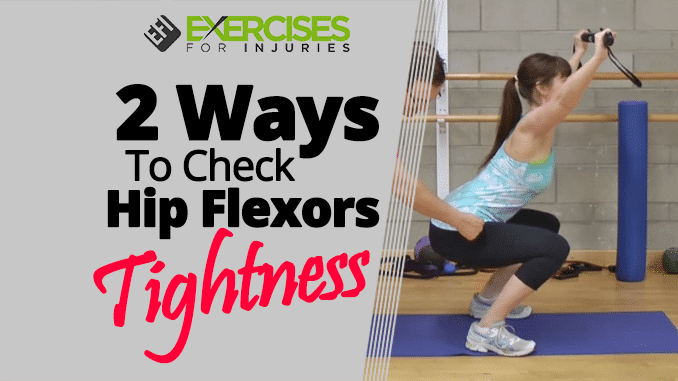If you’re going through hip flexor pain, it’s best to bring some relief by learning the three ways to check hip flexor tightness and see what you can do with it.
Hip flexor pain is the most common cause of hip and lower back problems. A lot of people all over the world have hip flexors symptoms. The pain can range from mild discomfort to chronic pain and even arthritis.
CLICK HERE to watch the ways to check hip flexors tightness YouTube video.
Hip Flexor Exercises
The hip flexors are a group of muscles that help you move or flex your leg and knee toward your body. They’re located near the front of the hips, just below the iliac crest (the top part) on each side. The main function is to bring your thigh bone close to your pelvis so it can be stable when standing upright or walking around. Hip flexor exercises also work other parts of this muscle group, including:
- Gluteus Maximus– The buttock muscle which extends from deep in the back by the tailbone/coccyx area all along the upper thighs down past knees; assists with raising both legs together off the ground for balance while sitting
- Iliacus– A flat, wide pelvic floor muscle under each half of the lower abs; helps raise one straightened leg at a time away from the midline and stabilize the spine during situps.
- Rectus Femoris– The rectus femoris is a muscle that attaches the pelvis to the knee. It’s also called your quad muscle, and it helps you to do squats or lunges.
- Sartorius Muscle– The sartorius muscle is a long, flat muscle that runs from the pelvis to the knee. It is used for flexing of joints and bending of limbs.
- Groin Muscle– The pectineus is a groin muscle that works in hip flexion, thigh rotation, and adduction. It’s also called the “groin muscle.”
Causes of Hip Flexors Tightness
Hip flexor strain is an injury when you use your hip flexors too much. It causes muscles and tendons to become inflamed, sore, and painful. Certain people are more likely than others to experience this type of pain.
Several factors can cause hip flexor tightness.
- Activities that require the hip to extend and rotate, such as running or kicking.
- Tightness in other muscles around your hips like hamstrings (back thigh) or IT band (outside the leg). This tightness may cause increased stress on the hip flexors.
- Weak abdominal muscles can lead to excessive arching in your low back when you lift something heavy off the ground with one arm.
Hip flexor tightness is classified into three grades depending on their severity:
- Grade I tear is a minor tear in which a few fibers are damaged. The hip still functions normally.
- Grade II tear: the muscle is partially torn and causes moderate loss of flexibility, making it difficult to stand or walk without collapsing from time to time.
- Grade III tear: the muscle is completely torn and can no longer bear weight – leading to complete paralysis below that area of injury.
Home Remedies
Resting and seeking treatment right away are important when you suspect a hip flexor injury. If left untreated, the condition could worsen, and recovery will take longer.
Home remedies include:
- Rest
- Ice
- Compression
- Elevation combined with anti-inflammatory medicine (seek a medical practitioner)
- Crutches
How do you know if you have an issue with your hip flexors? You will notice pinching when you squat. The common mistake is working on one of these muscles while ignoring the other, which is not solving the problem.
1. Pinching in the Hips During Squats
When you are doing a bodyweight squat with hands out front, you might notice pinching when you get to the bottom. You might also shift more to one side compared to the other side. These are signs of hip tightness. If you have tight hip flexors, you will have limitations in the hip on how far you can go.
2. Can’t Do Deep Squats
If you go through an overhead squat and have flexors, you won’t be able to go as deep as you can when squatting. Shifting to one side also affects the activation, endurance, and strength of the gluteus maximus. Your glutes being inhibited or affected by the hip flexor’s tightness will result in many issues when it comes to performance and injuries in the knee, hip, and back.
It’s important to remember that stretching is not enough. You will need multiple modalities to check hip flexor tightness. We should focus on two muscles, and stretching is not sufficient.
If you want to instantly release your hip flexors for more strength, better health, and all-day energy, check out the Unlock Your Hip Flexors program HERE.

